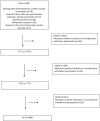Mortality in nursing home residents stratified according to subtype of dementia: a longitudinal study over three years
- PMID: 35382759
- PMCID: PMC8985279
- DOI: 10.1186/s12877-022-02994-9
Mortality in nursing home residents stratified according to subtype of dementia: a longitudinal study over three years
Abstract
Background: There are several subtypes of dementia caused by different pathophysiology and with different clinical characteristics. Irrespective subtype, the disease is progressive, eventually leading to the need for care and supervision on a 24/7 basis, often provided in nursing homes (NH). The progression rate and course of the disease might vary according to subtype. The aim of this study was to explore whether the mortality rate for NH residents varied according to the subtype of dementia.
Methods: NH residents were followed from admission to NH over a period of 36 months or until death with annual follow-up examinations. Demographic and clinical data were collected. The diagnosis of dementia and its subtype at baseline (BL) were set according to international accepted criteria. Kaplan-Meier analysis was performed to estimate median survival time. A Cox regression model was estimated to assess the impact of dementia diagnosis and demographic and clinical variables on mortality.
Results: A total of 1349 participants were included. When compared to persons with Alzheimer's disease (AD), persons with frontotemporal dementia (FTD) and dementia with Lewy bodies or Parkinson's disease dementia (DLB/PDD) were younger and had more neuropsychiatric symptoms. Median survival for the total sample was 2.3 years (95% confidence interval: 2.2-2.5). When compared to persons with AD, having no dementia or unspecified dementia was associated with higher mortality, while we found similar mortality in other subtypes of dementia. Higher age, male gender, poorer general health, higher dependency in activities of daily living, and more affective symptoms were associated with higher mortality.
Conclusion: Mortality did not differ across the subtypes of dementia, except in persons with unspecified dementia or without dementia, where we found a higher mortality. With a median survival of 2.3 years, NH residents are in the last stage of their lives and care and medical follow-up should focus on a palliative approach. However, identifying the subtype of dementia might help carers to better understand and address neuropsychiatric symptoms and to customize medical treatment.
Keywords: Dementia; Dementia subtypes; Long term nursing home residents; Mortality; Nursing home; Nursing home mortality.
© 2022. The Author(s).
Conflict of interest statement
The author(s) declare(s) that they have no competing interests.
Figures


References
-
- Gjøra L, Strand BH, Bergh S, Borza T, Brækhus A, Engedal K, Johannessen A, Kvello-Alme M, Krokstad S, Livingston G, Matthews FE, Myrstad C, Skjellegrind H, Thingstad P, Aakhus E, Aam S, Selbæk G. Current and Future Prevalence Estimates of Mild Cognitive Impairment, Dementia, and Its Subtypes in a Population-Based Sample of People 70 Years and Older in Norway: The HUNT Study. J Alzheimers Dis. 2021;79(3):1213–1226. doi: 10.3233/JAD-201275. - DOI - PMC - PubMed
Publication types
MeSH terms
LinkOut - more resources
Full Text Sources
Medical

